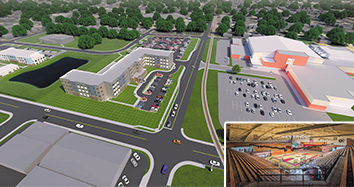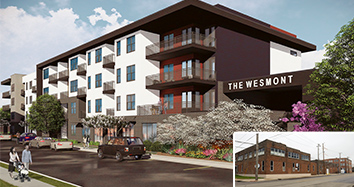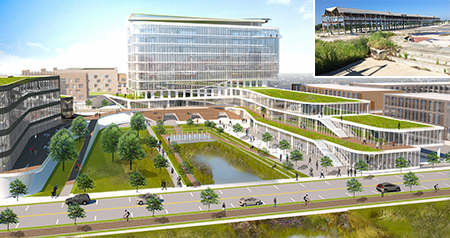Subscriber Benefit
As a subscriber you can listen to articles at work, in the car, or while you work out. Subscribe NowThe federal “opportunity zones” initiative, designed to spur investment in low-income communities nationwide, is still in its early stages—but it’s already grabbed the attention of local developers and investors.
Created as part of the federal tax legislation known as the Tax Cuts and Jobs Act of 2017, the initiative offers substantial tax breaks to those who invest their capital gains in a real estate development or business in a designated opportunity zone.
Perhaps the largest central Indiana project using opportunity zone funding so far is Waterside: a 103-acre, $1.4 billion mixed-use development that Indianapolis-based Ambrose Property Group plans to build at the former GM stamping plant just west of downtown.
“It’s an exciting time, and the opportunity zone designation played a big role in making this project possible,” Ambrose founder and CEO Aasif Bade said in an email.
Ambrose is seeking to raise a $350 million opportunity zone investment fund, and as of early July, had $49.6 million from 33 investors, according to public filings.
Bade declined to give more specifics about the fund and exactly how it will be deployed, citing U.S. Securities and Exchange Commission regulations.
Ambrose is far from the only developer tapping into the program.

Gary Hobbs, president of Indianapolis-based BWI LLC, said opportunity zone financing will be used for its $68 million redevelopment of the former Anderson High School, including its Wigwam gymnasium.
BWI built a $13 million apartment development on the property without opportunity zone financing but plans to build a $30 million assisted living center on the property and plow $25 million into the Wigwam, transforming it into the Wigwam Talent and Development Center, with that financing.
The building is slated to be used for a variety of purposes, including a fitness center, art galleries and an aquaponics farm.
“We’ll be leveraging opportunity zone dollars on that here this year,” Hobbs said.
BWI expects to attract opportunity zone investments for a few other developments, he added, though he declined to reveal details.
“We have the deals that are ready to go. Now, it’s trying to match with investors,” he said.
Picking up steam

Wesmont apartments on the former site of an IPS maintenance facility. (Rendering courtesy of TWG; IBJ file photo)
Hobbs was part of a committee that helped advise members of Congress on the opportunity zone concept as the legislation was being drafted; and he is part of O-Zone Reinvestment Advisors, an Indianapolis-based consulting firm that helps municipalities and developers attract opportunity zone investors.
Indianapolis-based TWG Development is also gung-ho on opportunity zone financing.
“It has been an effective tool. We’ve raised money with it,” said Tony Knoble, TWG’s CEO.
TWG is in the final stages of lining up financing for a 188-unit apartment project at East 16th Street and the Monon Trail called Wesmont. The $26 million project will be its first using opportunity zone financing.
“We like the program. We hope to use it a lot more,” Knoble said.
Indianapolis financial professionals also are seeing interest among their clients.
“I have a lot of clients actively looking at opportunity zone projects, both as developers and investors,” said Mike Fritton, a principal at Indianapolis-based Somerset CPAs and Advisors. “If I don’t get a call or an email or a question about opportunity zones every other day, it’s a slow week.”
 Indianapolis-based Valeo Financial Advisors LLC, which invests in real-estate projects on behalf of its clients, has closed on two opportunity zone projects, said Valeo financial adviser Will Logan. A third project is in the advanced stages but hasn’t yet closed.
Indianapolis-based Valeo Financial Advisors LLC, which invests in real-estate projects on behalf of its clients, has closed on two opportunity zone projects, said Valeo financial adviser Will Logan. A third project is in the advanced stages but hasn’t yet closed.
Logan declined to give details of the projects, citing client confidentiality, but he said all three projects are in Indianapolis’ Center Township.
Valeo got into the game early, Logan said, even as the fine points of the opportunity zone initiative were still being worked out.
“Last year was kind of fun because no one knew anything about it,” he said. “We’re trying to get at the very front of this so we can maximize its potential.”
Logan’s seen two waves of opportunity zone deals so far.
The earliest dollars went into existing development projects. “Those were going to happen anyway—they were already in the works,” he said.
Now, he’s starting to see projects specifically pitched as opportunity zone investments.
Pitching spree

As examples, several opportunity zones are on the city’s east side, where development activity has been less robust. But several encompass more prosperous areas, including Mass Ave, Fletcher Place, Fountain Square and downtown’s Mile Square.
An online portal launched in November to match up Indiana projects with potential investors also has attracted interest.
The portal is hosted by the Indianapolis office of the neighborhood-revitalization organization Local Initiatives Support Corp. It has teamed with a group of public and private organizations to form the Opportunity Investment Consortium of Indiana to promote opportunity zone investments around the state.
So far, developers or investors have posted 21 deals to the portal, including affordable and market-rate housing, mixed-use and office developments around the state, LISC said.
Since Jan. 1, the portal has had more than 2,100 visitors and more than 9,400 page views.
The consortium’s partners also have provided education about opportunity zones to more than 1,000 individuals, organizations and communities.
And the RACER Trust, formed to help clean up and redevelop former GM properties, is using the opportunity zone program as a selling point. In addition to the Indianapolis property Ambrose bought last year, several other RACER sites, including one in Anderson, are in opportunity zones.
RACER Trust is in discussions with prospects for “numerous” opportunity zone properties, according to RACER Trust Redevelopment Manager Bruce Rasher.
“We can’t know for certain whether the market’s recent interest in these properties is driven by the Opportunity Zone designation or by general favorable economic conditions,” Rasher said in an email. “However, it seems more than just a coincidence that these expressions of interest arose shortly after enactment of the [Tax Cuts and Jobs Act].”
‘We love this tool’
Opportunity zone funding can make projects more financially viable for developers, said Pat Gamble-Moore, senior vice president of community development banking at PNC Bank.
“I think it is making a difference. I think it is helping projects get done that wouldn’t have gotten done, or maybe making them stronger,” Gamble-Moore said.
Investors receive equity stakes in projects and must hold them at least five years. The maximum benefits kick in after 10 years.
That timetable takes pressure off a developer’s cash flow, Gamble-Moore said. With typical debt financing, a developer would be on the hook for monthly payments right away.
Including opportunity zone funds in the financing mix also can make affordable-housing projects more viable, because the project doesn’t need to generate as much rental income, Gamble-Moore said.
PNC hasn’t invested in opportunity zone projects locally yet, but it is involved in about 20 deals elsewhere in the United States, four of which have closed.
“We love this tool and think there’s great opportunity,” she said.
Even so, Gamble-Moore and others say opportunity zone funding by itself is not enough to transform struggling neighborhoods.
“This is a great tool, and it’s part of the capital stack, but it’s generally not going to be the only source in that deal,” Gamble-Moore said. “It’s not going to make a bad deal good.”
Fritton, the Somerset partner, said the local opportunity zone projects he’s seen so far are in areas that already have seen other investments.
“I haven’t seen a lot of large deals in what I would call under-the-radar areas or surprising areas,” he said. “I think right now you’re seeing investment dollars flowing to some of the lower-hanging fruit.”
Over time, as more people come to understand how opportunity zones work, Fritton predicted, investment will flow to some of the city’s most needy neighborhoods.
Several financial professionals say many developers and potential investors are still getting up to speed on how opportunity zones work, which has slowed initial participation.
Further complicating that learning process are several rounds of guidance the Internal Revenue Service has issued since the program launched last year.
Keith Broadnax, senior vice president of business development for the Indianapolis office of community development group Cinnaire, said his office is among those still feeling their way.
Cinnaire is preparing to set up opportunity zone funds for investors, and also is reaching out to new partners that might be sources of capital—wealth management advisers at banks, for instance, or community foundations interested in social-impact investing.
“I’m convinced that this is eventually going to take off, but we need to know what we have here,” he said. “It’s still new. We’re all still feeling our way around this.”•
Please enable JavaScript to view this content.


So basically all of downtown is an opportunity zone. That wouldn’t be the case if Indy was an economically healthy city. It’s not, though. It’s more like Detroit, Baltimore and St. Louis than it is any place where thinking people would want to live.
There is really no reason for this level of pessimism. Indy is not perfect but it is not the slightest bit similar to the cities to which you compare it. And furthermore, you didn’t even bother to do any research before making this post. Designated areas were eligible for the following reasons:
The tract has a poverty rate of at least 20%; OR
(A) For a census tract in a metropolitan area, the tract’s median family income does not exceed 80% of the greater of: the metropolitan area median family income or the statewide median family income; or
(B) For a census tract in a non-metropolitan area, the tract does not exceed 80% of the statewide median family income.
So an area can be designated if the median income in that tract doesn’t exceed 80% of the states median income. That gives zero indication about the economic health of downtown which seems to be the point of your post. I live downtown and there is extraordinary development happening everywhere – projects that weren’t the slightest bit feasible 15 years ago are now happening in large numbers. This is a great opportunity to incentivize investment in downtown and our Governor did a great job in nominating tracts that serve to bolster the development that is already well under way. It’s a fantastic strategy for a rapidly developing, under-the-radar great city to live in.
The NY Times just did a great expose about the Opportunity Zone tax break scam. In short, many affluent and economically healthy areas have been designated as “opportunity zones” for this giant tax give-away. Places like downtown Houston, the very trendy and pricey Design District in Miami, and trendy and booming neighborhoods in LA, Nashville, etc. Hell, even Manhattan has “opportunity zones” in neighborhoods that have seen luxury residential development and new office construction. So, the issue is not the economic health of downtown Indy, but rather that the whole “Opportunity Zone” tax break is one big scam that is nothing more than government welfare for rich developers.
Whatever you say Daniel